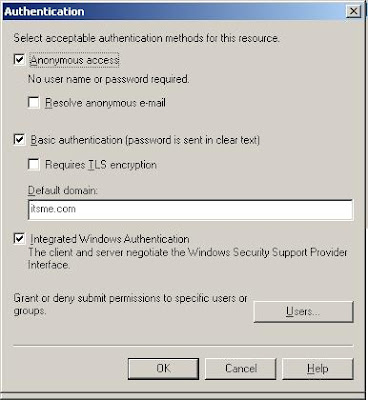Friday, March 28, 2008
Exchange2007:Edge Transport Role
[PS] C:\Windows\System32>New-EdgeSubscription -file "c:\edgesubscription.xml"
New-EdgeSubscription : When running this task inside the organization, the sit parameter is required.
At line:1 char:21+ New-EdgeSubscription <<<< -file "c:\edgesubscription.xml"
How do I change the computer name back if I don't remember the old computer name?
Event Viewer --System
The NetBIOS name and DNS host name of this machine have been changed from WIN-UUNQIEUZCTN to EDGECOMPUTER.Event.
The old computer name is WIN-UUNAIEUZCTN.
Change the computer name back to WIN-UUNAIEUZCTN.
Observation: don't rename your computer name after you install Exchange Server.
Wednesday, March 26, 2008
Vista: how to re-install Windows Mail
fix:
sfc /scannow
Monday, March 24, 2008
Outlook: Export to pst file and import it into another account
Open outlook as Kevin Smith
File menu--Import and Export;
Export to a file; -->personal folder file (.pst)

Open outlook as Tom Hicken, File menu--Import and Export --Import from another program or file --PST file
Saturday, March 22, 2008
Exchange2003: Relay and SMTP virtual server
Scenario 1:


For POP3 and IMAP clients to send e-mail through the SMTP virtual server, you must select the following:

 -----
-----Send test e-mail message: Cannot send the message. Verify the e-mail address in your account properties. The server responded: 454 5.7.3 Client does not have permission to submit mail to this server.


As shown above, the relay restriction is set to "Only the list below" but the list is empty. With "Allow all computers which successfully authenticate to relay, regardless of the list above" option selected, if outlook client is set to "my outgoing smtp server requires authentication", pop3 and IMAP clients can send e-mail through the SMTP virtual server.
With ANONYMOUS AUTHENTICATION unchecked, other SMTP server cannot send e-mail to your domain.
That is why we should create one SMTP virtual server for accept SMTP connection. The relay restriction should be "only the list blow" with empty list and uncheck "allow all computers which suchessfully authenticate to relay, regardless of the list above". The SMTP port will use the 25. Then, create another SMTP virtual server for authenticated POP3 and IMAP clients relay. The SMTP virtual server will use a port other than 25.=========================
Scenario 3:
With the default authentication of SMTP virtual server (anonymous access, basic and integrated windows authenticaion), the following settings will set the SMTP virtual server to relay e-mail for everyone, including anonymous user. Don't use the option.
Sunday, March 16, 2008
Exchange2007: Configure the File Share Witness
Create a shared folder: witness
Assign the ClusterAdministrator (cluster service account) with FULL access permissions on both shared permission and security permission.
configure the MNS quorum to use the file share witness
On Cluster NODE1:
Cluster mycluster res "Majority Node Set" /priv MNSFileShare=\\ExClientServer.itsme.com\Witness
System warning 5024 (0x000013a0).
The properties were stored but not all changes will take effect until the next time the resource is brought online.
Run the following command (twice)
Cluster mycluster GROUP "Cluster Group" /MOVE
Cluster mycluster Group "Cluster Group" /Move
If you have other resource groups, run "Cluster mycluster GROUP "other group" /move
========================
Make sure that both S2003Ex1 and S2003Ex2 are the owner of the Cluster Group resource. And make sure S2003Ex1 owns the Cluster Group.
Run Exchange 2007 SP1 on S2003Ex1;
It works.
==========
According to Microsoft Recommendation, an alias for the computer name: ExClientServer should be used.
By default, computers running Windows Server 2003 do not listen for requests using alias names. As a result, connection attempts may fail with the following error message when hosting the file share on Windows Server 2003: "System error 52 has occurred. A duplicate name exists on the network."
You must create a registry value.
HKEY_LOCAL_MACHINE\System\CurrentControlSet\Services\LanmanServer\Parameters
Add Value, and then add the following registry value:
Value name: DisableStrictNameChecking
Data type: REG_DWORD
Radix: Decimal
Value: 1
Exchange2007: Create a Windows cluster for Cluster Continuous Replication

S2003Ex1:
Cluster Administrator console--New Cluster Wizard --mycluster


If any physical disk resources are present, they should be manually removed before adding the second node to the cluster. How do I understand its meaning? I remove all the SCSI drives and its adapters from the Virtual Machines.

 Network configuration:
Network configuration:


Make sure that Public NIC on both clustered computers has high priority. Open the Network Connections windows--Advanced Menu--Advanced Settings
Exchange2007: fail to remove the last mailbox role

 Then, retry the REMOVE process.
Then, retry the REMOVE process.Saturday, March 15, 2008
Exchange2007: Mailbox role in a Clustered environment



 ======
======

 =====
=====
Wednesday, March 12, 2008
Vista: Diskpart -System Recovery Options
Start the computer from the Windows Vista product DVD.
-->Repair your computer,
-->System Recovery Options dialog box,In the next System Recovery Options dialog box, click Command Prompt.
At the command prompt, type diskpart, and then press ENTER.
-->select disk 0.
-->clean
-->create partition primary size=1500
-->assign letter=S
--> active
--> create partition primary
-->assign letter=C
-->list volume
--> exit
--> format c: /y /q /fs:NTFS
--> format s: /y /q /fs:NTFS
-->exit
To install the Vista in the C: drive, the large partition,
In the System Recovery Options window, use the close window icon in the upper right (or press ALT+F4) to close the window to return to the main installation screen. (Do not click Shut Down or Restart.)
Click Install now and proceed with the Windows Vista installation process. Install Windows Vista on the larger volume, C: (the operating system volume).









